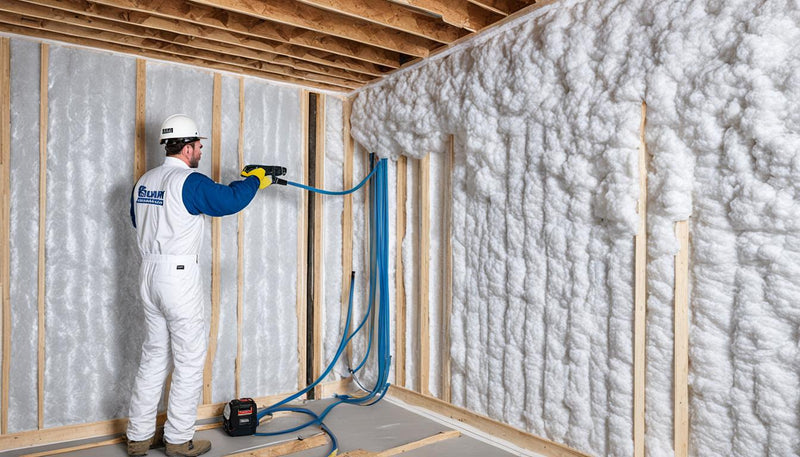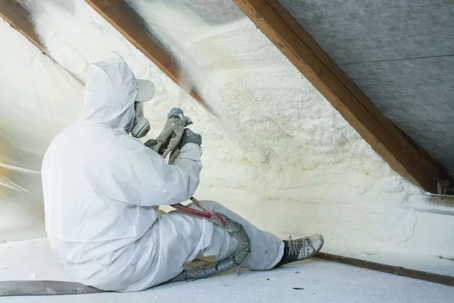The Process of Applying Spray Foam: What You Need to Know
Spray Foam: The Ultimate Remedy for Air Sealing and Insulation
Spray foam insulation has actually arised as a leading option for efficient air sealing and thermal insulation, providing a distinct combination of residential or commercial properties that set it apart from traditional approaches. Recognizing the complete range of its benefits, installation procedures, and contrasts with various other insulation types is important for making informed choices.
What Is Spray Foam?
Spray foam is a functional insulation product that integrates the principles of air sealing and thermal resistance to boost power efficiency in buildings. Made up largely of polyurethane or various other similar substances, spray foam is used as a liquid that expands upon call with surfaces, creating a strong, constant layer of insulation. This distinct home allows it to load spaces, cracks, and spaces that typical insulation products may ignore, supplying a superior air seal.
There are two primary sorts of spray foam: open-cell and closed-cell. Open-cell spray foam is lighter and more adaptable, providing superb noise absorption and a reduced R-value per inch - Spray Foam. In contrast, closed-cell spray foam is denser, giving a higher R-value, dampness resistance, and added architectural honesty to developing parts
The application process commonly includes customized equipment, making sure a smooth application that sticks to various substrates, consisting of steel, concrete, and timber. This adaptability makes spray foam suitable for both brand-new building and constructions and retrofitting existing structures. Its capacity to develop an airtight obstacle dramatically contributes to decreasing power intake and improving indoor air high quality, therefore making it a preferred option amongst builders and property owners alike.
Benefits of Spray Foam Insulation
One of one of the most substantial benefits of spray foam insulation is its remarkable capability to develop a continuous air barrier, which efficiently lessens power loss. Unlike standard insulation products, spray foam increases to load gaps and cracks, ensuring that air leakage is dramatically minimized. This particular not just enhances energy efficiency but also leads to decrease energy costs with time.
In addition, spray foam insulation gives superior thermal resistance, adding to a more stable indoor environment. Its high R-value per inch enables reliable insulation in constrained rooms, making it ideal for attic rooms, wall surfaces, and crawl areas. Moreover, the moisture-resistant residential or commercial properties of spray foam help protect against mold and mildew and mold growth, advertising healthier living problems.
An additional vital benefit of spray foam insulation is its sound-dampening top qualities (Spray Foam). It successfully reduces sound transmission between areas, producing a quieter and more comfy home environment. The longevity of spray foam likewise stands out, as it does not sag or settle gradually, maintaining its efficiency throughout its life expectancy
How Spray Foam Functions
Understanding just how spray foam insulation works is crucial for appreciating its performance in air sealing and thermal resistance. Spray foam insulation includes 2 primary elements: isocyanate and polyol material. When these components are combined, they undergo a chain reaction that creates the material to broaden swiftly, creating a dense foam that loads cavities, fractures, and spaces.
As the foam increases, it follows surfaces, developing a closed seal that dramatically reduces air infiltration. This characteristic makes spray foam insulation extremely reliable at preventing drafts and moisture penetration, which can cause power loss and damages with time. In addition, the closed-cell variant of spray foam provides remarkable thermal resistance as a result of its inflexible framework, properly decreasing heat transfer.
The unique residential properties of spray foam permit it to adjust to uneven surface areas, making certain thorough insurance coverage and a smooth obstacle. Consequently, spray foam insulation not just boosts power effectiveness however likewise contributes to improved indoor air quality by reducing the accumulation of toxins and irritants. Inevitably, comprehending the auto mechanics behind spray foam highlights its function as an exceptional option for insulation and air securing in both commercial and residential applications.
Installation Refine Summary

Before setup, the room should be appropriately cleaned and prepped, making sure that surface areas are totally free from dirt, particles, and my site moisture. Since pollutants can endanger attachment and total efficiency, this action is crucial. Once the area is prepared, the application includes mixing both elements of the spray foam, which broadens upon call and loads voids properly.
Educated specialists need to perform the installation, utilizing specialized equipment to ensure uniform coverage and optimal thickness. Safety and security preventative measures, consisting of putting on safety equipment and making sure appropriate ventilation, are critical throughout this procedure. After application, the foam normally remedies rapidly, forming a solid obstacle that improves energy efficiency.
Comparing Spray Foam to Typical Insulation
When evaluating insulation alternatives, spray foam insulation attracts attention in contrast to standard materials such as fiberglass and cellulose. One of the primary benefits of spray foam is its remarkable air sealing capabilities. Unlike fiberglass and cellulose, which can permit air seepage, spray foam broadens upon application, filling gaps and holes to create an impermeable seal. This leads to enhanced power efficiency, as much less warmed or cooled air escapes the home, bring about lower energy expenses.
Furthermore, spray foam gives a higher R-value per inch than typical insulation types, supplying more reliable thermal resistance in a thinner profile. This particular is particularly helpful precede with restricted cavity depth. Spray foam is resistant to wetness and mold and mildew growth, which can be a considerable problem with cellulose and fiberglass, particularly in damp settings.
However, spray foam insulation usually lugs a higher upfront expense than its typical equivalents. Property owners need to consider this initial investment against long-lasting power financial savings and efficiency benefits. Ultimately, while both insulation types serve their function, spray foam becomes an advanced service for contemporary insulation requirements, especially in regards to air securing and thermal performance.

Verdict
In recap, spray foam insulation stands for an extremely efficient option for accomplishing ideal air sealing and thermal resistance. Its distinct homes, including moisture resistance and sound dampening, make it suitable for numerous applications in both brand-new buildings and retrofitting jobs (Spray Foam). Although the preliminary costs might be greater compared to conventional insulation materials, the lasting advantages, such as considerable energy savings and boosted interior air high quality, justify the financial investment and emphasize its value in modern structure techniques.
Spray foam insulation has arised as a leading service for over at this website effective air sealing and thermal insulation, supplying a special combination of residential or commercial properties that establish it apart from standard methods.Spray foam is a functional insulation material that incorporates the principles of air sealing and thermal resistance to improve power performance in buildings.When evaluating insulation choices, spray foam insulation stands out in contrast to traditional products such as fiberglass and cellulose. Eventually, while both insulation kinds offer their purpose, spray foam emerges as an extra advanced option for modern insulation requirements, specifically in terms of air sealing and thermal click to find out more effectiveness.
In recap, spray foam insulation represents an extremely reliable solution for accomplishing optimum air sealing and thermal resistance.